
Hi Archinect!
Vito Acconci was in Piper tonight. Andrew Zientek, MLAII, and Krzysztof Wodiczko, the GSD's Professor in Residence of Art, Design, and the Public Domain (yes, that is his actual title), provided heartfelt introductions. Acconci himself spoke in a straightforward manner, without notes in front of the podium, with a kind of gravelly, stuttering voice that left no distinction between a verbal tick and the poetic repetition of words.
What he said went something like this (note: this is a very loose paraphrase/summary):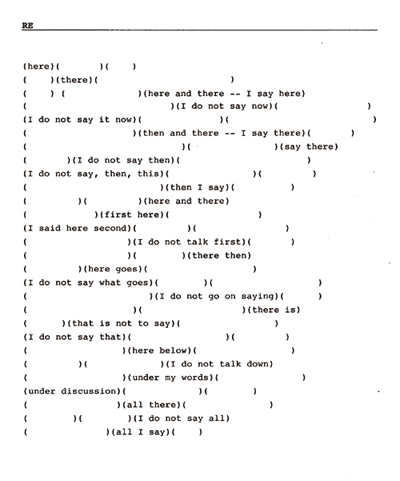
"I started with writing. I was a writer. I wanted words to be as literal as possible, for them to be concrete and for them to matter. I wanted a poem to be about going from left margin to right margin, from top to bottom. To be about moving through this space.
[I started writing walks] and once I was doing that, making the writing into space, there was no way back. I was working with space. 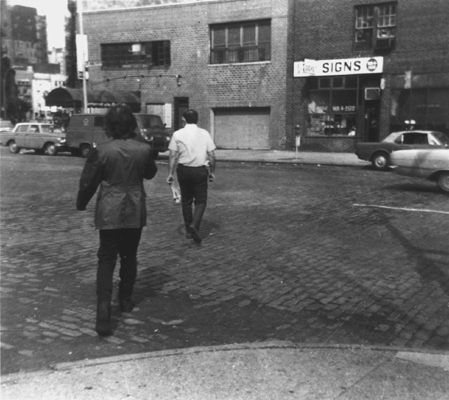
So I started to perform pieces in which I would follow a person through public space all day until they went into a private space.
After doing a few of these pieces, I started to wonder if I was cheating--if I was not putting enough of myself into the piece.
So I started doing things to myself, applying physical stress to my body, seeing how my body reacted.
I did video pieces like Conversions, in which I had a camera and a lit candle. The candle provided the light for the video. The video shows me holding the candle. I brought the candle to my chest, and the rest of the video shows me burning the hair off of each breast, after which I pulled my breasts out, pulling them. 
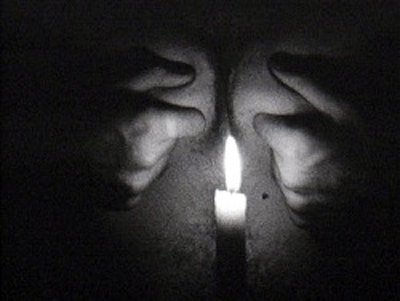
Pulling them, trying to make them into womens' breasts. Obviously there are easier ways to look like a woman, which was my clue that this wasn't the point for me. What I wanted is that I wanted to be like the little engine that could--to do something that I couldn't do. To say "I think I can, I think I can."
So I did a piece in which I stood at the bottom of the stairs with a blindfold and a lead pipe. I swung the pipe and talked to myself constantly, things like: "I'm alone in the basement. I want to be alone here. I'll hate anyone who tries to come down here." So I was working myself into a kind of trance in order to believe this. And if someone tried to come down, I'd swing the pipe at them. I had to wear a blindfold because if I could see the person, I wouldn't be able to swing the pipe at them. They had to remain abstract intruders. So I wore a blindfold.
But I realized that everything that I hated about art--art as a kind of religion, art as an altar, the artist as a kind of priest--I found I was enhancing. I was the center of everything, making a kind of cult of myself. 

So I did a piece in which I sat under a ramped floor of the art gallery. And people would walk up there readily and I was underneath. And my goal was to masturbate all day. I used the footsteps of the visitors in order to propel my fantasies. Oh, and I would talk out loud about my fantasies, saying: I'm running my hand down your back, I'm touching your hair, and so on. And once in a while when the masturbation reached its end, maybe the visitor could feel that I did something for them, that there was a connection, that somehow the private space under the floor extended into the social space above. 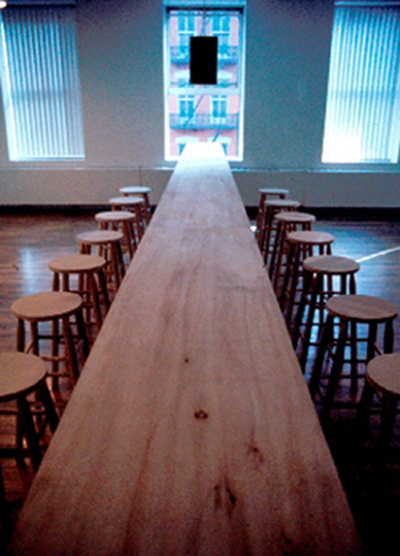
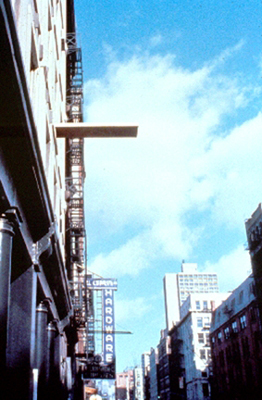
But then I thought that if I couldn't be seen, maybe I didn't have to be there at all. So I started to do installations. Installations could be anything: a painting is installed, a rug is installed, a table is installed. The people who were talking about the things that we were doing, calling them installations, were looking for what to call this. 
This one, you go inside and sit on the swing. When you sit on it, the swing starts to come down and the walls fold up. So it's a house that exists in a different way for you and for someone outside, and only when you are inside it.
But I wanted to make something that's more like a building. I had to work with architects or at least with people who were learning to be architects. I was obsessed with ideas like: "live by the sword, die by the sword." So if the art is to be public, it's origin has to be public. And I thought that the public starts with three: one is solo, two is a mirror image, and three starts an argument, is the beginning of a public.
So I started Acconci Studio. It was not so much me deciding what to do and other people carrying it out. It is a conversation and we figure out what we're doing together. Architects tell me it's much noisier than most architecture studios. There's music on.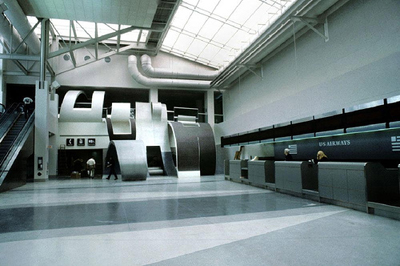
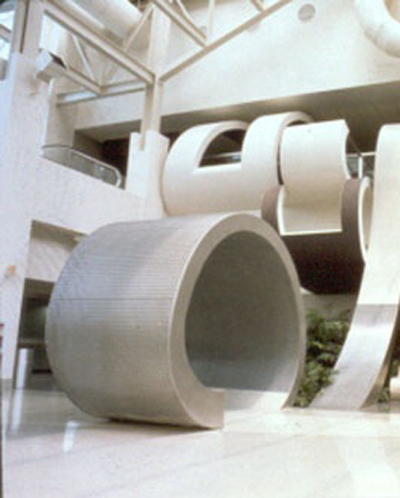
Public art exists because of the 1% for art laws. You make a building and 1% goes to the art. So I did a few pieces. This one in the Philadelphia International Airport is at the end of the space. There's nowhere else to go so the ground plane rolls up to make a place to sit, and the walls roll down.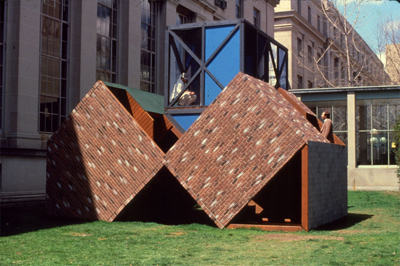
At first I thought that by doing public art you could do more because people don't notice it as much. But then I thought that if it's 1%, then the art can only ever be worth 1% of the building.
A small magazine in New York asked us to redesign the umbrella. They said there hadn't been a new design for the umbrella in many years. So our first idea was the Umbruffla, a combination of umbrella and ruffles, that used the ruffles to unfold itself over the body.
We'd love to do a kind of suit that reacts to the body through a series of attractor points. Say you pick five points on the body: two nipples, a belly button, a vagina or penis, an asshole. These become attractors in a kind of two-way skin suit. but for the suit to move, you'd have to have a way for the nipples and asshole to jiggle around and we haven't figured out how to do that.
And we started to do things that move away from the body. So the next step away from the body is utensils. Alessi asked us to do something for them and we did these coffee pots..."
...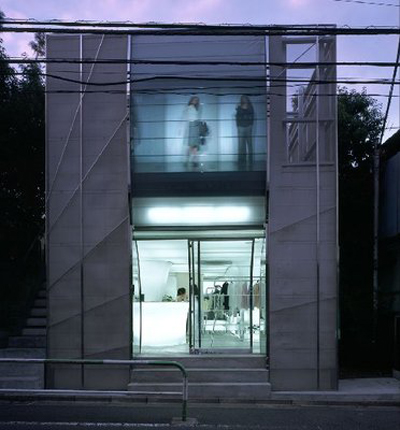
And we did this store for the United Bamboo Store in Tokyo. If you go into the dressing room and like how you look, you can press a button on the dressing room door and you become the model shown on the outside of the building.
...
The last section has to do with operations. This comes from my background in installation and performance art. We tend to make places that are not so much nodes or stopping places, but activity places. We're interested in endless spaces. We used this idea of a Klein bottle, and if we perforate it, children climbing inside could come face to face with children climbing outside.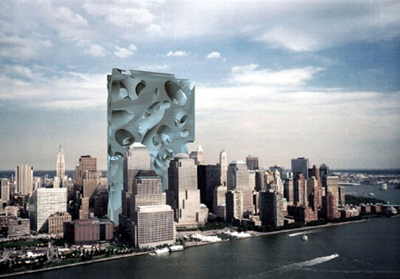
Operation number one: make a world. Then poke a hole in the world. Like a lot of people at the end of 2001 and beginning of 2002, we made a hypothetical proposal for the World Trade Center. We thought that if buildings get exploded we could make them already exploded.
He ended the talk by saying "I guess this gives a pretty good idea, maybe too much of an idea, of how I went from poetry to art to design. So maybe we can turn on the lights and see if anybody wants to talk."
...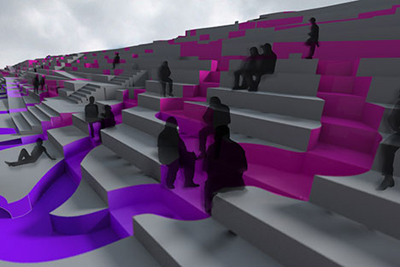

The work since around 2000 has engaged the architectural obsessions of the moment: re-jigging program; playing geometrical games like folding, puncturing, and using mobius strips and Klein bottles; thinking about the continuity of surface; using ornament to create perfomative elements like seating; and the unhinged creation of wildly expressive forms. He started naming geometric operations that drove his projects. Operation number eight was "folding and embedding." Operation number nine was "swirling and swooping."

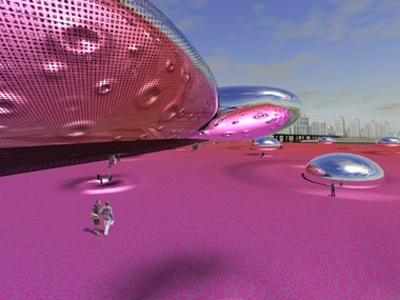

Is this the same guy who masturbated under the floor of an art gallery while heckling visitors for some ten hours straight every day?
The arc of the lecture was surreal. It was amazing to see how continuously Acconci reinvented himself, becoming a different artist in response to the project before it and reflecting the questions and preoccupations of his time. In the 60s and 70s: critical, transgressive. In the 80s: pomo, corporate. More recently: playing with geometry and fabrication to make things that are playful, smooth or not smooth, wildly speculative. Acconci brings his inventiveness and imagination to all of his work, but it's hard to get over the kind of indifferent flashiness of the renderings since the early 2000s.
The lecture closed with Q+A, and this showed Acconci at his best; humble, humorous, generous, incisive. And he was thoughtful about the trajectory of the work; in response to a question about bringing performance back into his mode of work, he said "I don't think performance can work that way anymore. It becomes exhibitionism today, and that's not what I want to do."
I'm not sure if I can all of this sum this up in any kind of satisfying way. But maybe I can just say that for me the event provided a particular view of thinking about the past fifty years and asked some difficult questions about where we're at today.
Thanks for reading,
Lian
P.S. Electronic Arts Intermix for his earlier work and his website for his current stuff.
P.P.S. You can view Vito Acconci's lecture here. More generally, the GSD's website for lecture webcasts is here.
This blog was most active from 2009-2013. Writing about my experiences and life at Harvard GSD started out as a way for me to process my experiences as an M.Arch.I student, and evolved into a record of the intellectual and cultural life of the Cambridge architecture (and to a lesser extent, design/technology) community, through live-blogs. These days, I work as a data storyteller (and blogger at Littldata.com) in San Francisco, and still post here once in a while.



8 Comments
Awesome, Thank you so much for getting this down for those that couldn't be there.
Let us know if the GSD records these lectures and puts them online as some schools do. Not that your rendition is lacking, but I would love to have heard this.
Lian
I've been a dedicated follower of your blogs and I have to say you're very receptive to what the GSD does. I am curious as to see how you and your fellow students affect the school as well. I guess I just don't have much of a sense of what students are doing for the school and the greater architecture community.
Thanks for the comments!
@Messner: Yes, many lectures are recorded and posted here: http://www.gsd.harvard.edu/events/webcasts/
@AAbelS: Thanks for your question. Students are the school, in many ways. The Acconci lecture, for example, was organized by Andrew, a fellow Archinect blogger from the Landscape department. There's a student exhibition wall that changes exhibits regularly (sometimes once a week), and there are student organized lectures and events all the time--literally at least a few different things going on each weekday (and many weekend days) during the semester. Many of the events I blog about are organized by students although I might not necessarily mention that. Asia GSD (one of our many student groups) collaborated with Dean Mostafavi this semester to organize a lecture series featuring Japanese architects (Sou Fujimoto, Junya Ishigami, Seijima + Nishizawa, Toyo Ito). And the interests of students and the culture on the trays push back on pedagogy and the priorities of the school in different ways.
As for contributing to the community, there's a strong tradition of this at the GSD, although this is also balanced by an understanding that this is a school, not an NGO, and certain agendas can best be advanced outside the formal structure of the institution. So for example, last semester Shigeru Ban's studio built structures out of paper tubes, and used their studio to develop strategies for housing in emergency situations. Some of their work went to Haiti to help with relief efforts, but this didn't mean that the studio's entire output and activity was devoted towards the humanitarian project. The work still had to have pedagogical value in terms of architecture. If students want to focus much more on the humanitarian side of things, they'd have to do that in an extra-curricular context with one of the student groups or, for example, on a summer Community Service Fellowship which offsets the costs of doing this kind of project either domestically or around the world.
So the school finds different ways to support student-driven initiatives (like Project LINK, Social Change and Activism (SoCA), MASS Design Group, etc.) To find out about these, here are a few relevant links:
http://www.gsd.harvard.edu/people/students/student_forum/groups.html
http://www.gsdsoca.blogspot.com/
http://yesnoyesno.net/
http://vimeo.com/19953966
http://www.massdesigngroup.org/
http://www.discoverprojectlink.com/
Oh, and J term (a short semester in January with non-credit courses) is largely a student-driven, school-supported affair: http://www.gsd.harvard.edu/people/students/student_forum/jterm/
I taught one workshop (on Grant Writing) and co-led a seminar (on Body States) in this year's J term, and last year I attended a few workshops.
In direct response to your final paragraph, Lian, this was a verysatisfying summation. I've been familiar with Acconci's work for a long time of course (I'm old) but to have the arc of his career presented in the arc of the lecture so consisely iwth great images is wonderful.
I met Vito a couple years ago - we're both working on the same collection of public art pieces, the Indianapolis Cultural Trail. He is an amazing person - thoughtful, broad-ranging, curious, insightful. GLad you had the opportunity to hear him speak and enjoyed it so much - and thank you for sharing!
Thanks, Donna! I'm glad to hear that what I wrote sounded right to you... and even more that you have also been able to benefit from contact with Acconci. He does seem like an extraordinary human being, from my short observation of this event...
very nicely done lian, as always. thanks for that.
thanks, jump!
Block this user
Are you sure you want to block this user and hide all related comments throughout the site?
Archinect
This is your first comment on Archinect. Your comment will be visible once approved.